Swart | Edward Cornelius Martin
- First names
Edward Cornelius Martin
- Age
24
- Date of birth
09-10-1920
- Date of death
05-11-1944
- Service number
1486325
- Rank
Sergeant
- Regiment
Royal Air Force Volunteer Reserve,102 Sqdn.
- Grave number
III. A. 9.
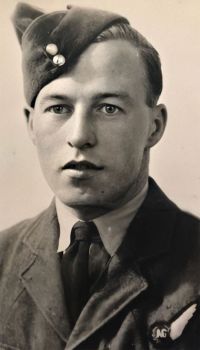
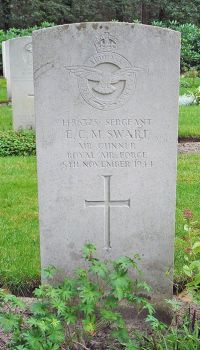
Biography
For this biography, all credits go to Lennard Bolijn of the team TracesofWar who, with the cooperation of Edward’s family and based on an endless list of external sources, has compiled this biography.
At Lennard’s request, we largely reproduce this biography but are happy to refer to extensive information and source references on various parts of Edward’s page on TracesofWar in English and TracesofWar in Dutch.
Many thanks therefore go to him and all the sources we mention at the bottom of this biography.
History
The story of Edward Cornelius Martin Swart began on 9 October 1920 in the village of Wath upon Dearne, South Yorkshire, near Rotherham in England. He was named after his grandfathers: Edward on his mother’s side and Cornelis Martinus on his father’s side. Edward was born the second child and first son of the parental couple Gijsbertus de Swart (later also known as George Swart) and Beatrice Swart-Joel. At that time, they already had a daughter, Marie (18 September 1919, Sheffield). In the following years, the family grew to eight members with Edward’s younger brother Sidney (6 May 1923, Schiedam), his younger sister Beatrice and his younger brothers Geoffrey (3 May 1930) and George (1935).
Dutch ‘roots’
As their surname suggests, part of the Swart family’s family history lies in the Netherlands. Indeed, father Gijsbertus de Swart was born on 6 August 1896 in Buren, Gelderland. In his early years, Gijsbertus moved frequently with his parents. After Asperen (from 22 April 1899), Kedichem (from 14 September 1910) and Nieuwerkerk aan den IJssel (from 1 January 1914), the De Swart family finally ended up in Schiedam on 10 July 1915.

In the family, the story goes that Gijsbertus then moved to England to avoid military service. According to the family card of the municipality of Schiedam, Gijsbertus did remain registered in Schiedam. The rest of the De Swart family also lived in Schiedam until at least 1924, but each child left the municipality on a different date.
Once in England, Gijsbertus married Edward’s later mother, British Beatrice Joel, in 1919. Beatrice Joel was the daughter of Ed(ward) Henry Joel and Eliza Ann Joel-Cox. Gijsbertus and Beatrice married at the Registry Offices in West Barr, Sheffield on Easter Sunday, 19 April 1919. The same year, their daughter Marie was born.
Back to Schiedam
Family notes show that following Edward’s birth on 29 November 1920, the family of four left Sheffield shortly afterwards for Hull, to board the steamship Jerveaulx Abbey on a voyage to Rotterdam. Edward was three weeks old at the time. Now that World War I was over, Gijsbertus could again show up in Schiedam without any problem, where he was still registered. It is believed in the family that Gijsbertus and his family stayed with his parents after their return, with the intention that this stay would last several weeks. However, Beatrice fell ill, so this ended up lasting no less than four years. Beatrice had extremely bent legs, having had rickets (English disease) in her childhood. Also, she may have had a heart condition. It is unclear how long the family planned to stay in the Netherlands, but a four-year stay with Edward’s grandparents was surely not in the cards. This extended stay meant Sidney was the only one of the children born in Schiedam. Gijsbertus, meanwhile, was working as a gas fitter, according to the family card of the municipality of Schiedam.
Final destination Engeland?
Dutch was the first language in the household, but on 29 July 1924 the family moved again, this time back to Sheffield, back to mother Beatrice’s native soil. Here they lived satisfactorily for the next few years, while more children enriched the family.
In the year 1931, factory manager Frank Parkinson went to Sheffield to recruit staff for his factory’s glassworks in Guiseley, near Leeds in Yorkshire. Gijsbertus accepted the offer and the family moved again, to Guiseley. Apparently Gijsbertus, like his father by now an experienced glassblower, had numerous Dutch and Belgian friends in Sheffield. Some came with him to Guiseley, where their friendships continued. Partly because of these friendships, Dutch was still widely spoken at home.
Some more years passed, until almost 12 years after their immigration to the UK, Gijsbertus naturalised as a Briton on 10 January 1936. He would go on living under the name ‘George Swart’, as he had probably been calling himself for some time. Sidney, the only one of the children also born in the Netherlands, also naturalised this day. Edward and his siblings, like their mother Beatrice, would from now on adopt the surname Swart, without the Dutch ‘de’. In 1940, father George died.
Military career
Edward enters the service
After Edward’s childhood in Sheffield and Guiseley, he went straight from school to work in the glassworks of Frank Parkinson’s factory, where his father also worked. Generations in his family had preceded him as a glassblower, but Edward did not like this work, so not much later he went to work as a weaver and stockman at Edward Denison and Co in the Westfield Mills wolf factory. This factory was in Yeadon, West Yorkshire, not far from Guiseley.
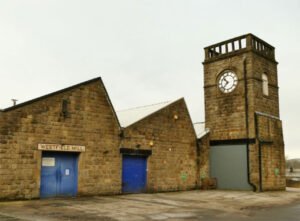
It is unknown how long he worked at both factories, but World War II had started by now and the UK was at war.
Although there is evidence that his younger brother Sidney enlisted in the army (in the Reconnaissance Corps) and his other brother Geoffrey eventually joined the army as well, Edward saw more merit in a role in the RAF. So on Wednesday 30 July 1941, he went to no.3 recruitment centre RAF Padgate, between Liverpool and Manchester, to enlist as a Royal Air Force Volunteer Reserve. Here he received his service number 1486325 and began his military career.
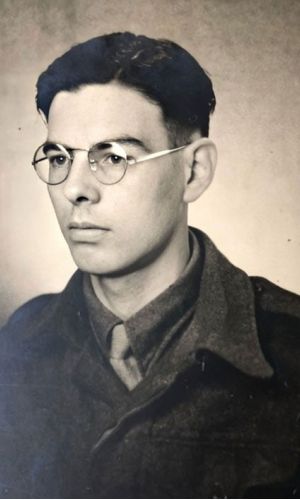
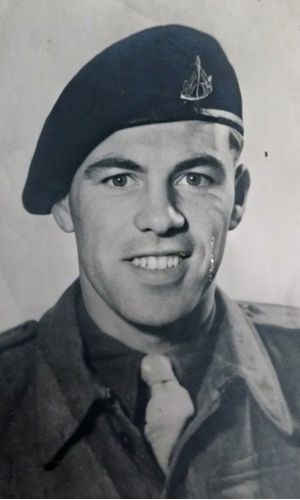

Turbulent times in training
In the years that followed, Edward saw a good part of the UK. His record shows, among other things, that via Recruits Centre Blackpool, an Aircraft Delivery Unit and a Reception and Disposal Unit, he finally joined a squadron for the first time only on 28 November 1942, the 2769th at West Malling and later Biggin Hill, both south of London. Via RAF Hunmanby Moor in northern England, a training camp, he joined an Initial Training Wing on 11 September 1943, probably at St Leonards in Sea and Bridlington, also located in northern England.
It was probably here that Edwards’ training really began, as a month later on 23 October he entered the Air Gunners School, where he was trained to his eventual position of air gunner. Through another training unit and a ‘Ferry Pilots Pool’, Edward was assigned to his final squadron, the 102nd ‘Ceylon’ squadron at RAF Pocklington, about 20 kilometres east of York, on 25 July 1944. This was then already his twenty-fifth entry in his ‘unit file’.
By this time, Edward had risen through four promotions and one demotion to Temporary Sergeant, at the time of his Air Gunner School.
At Ceylon Squadron
A month after Edward joined the squadron, he experienced his first ‘combat flight’ as an Air Gunner, in Flight Officer A.C. Cameron’s crew. This daytime flight on 15 August 1944 in a Halifax III with registration LW158 made an attack on the ‘airport runway’ of Fliegerhorst Eindhoven, the Netherlands. Edward was thus back in the Netherlands for a while after all, if only briefly and in the air.
During August, September and October, Edward completed a total of twenty missions in various crews. He invariably flew in Halifax IIIs, most often (five times) in the aircraft with registration number MZ800. He participated in missions by day and night on targets in the Netherlands, Germany and France. Special flights included three planned ‘Gardening sorties’, where mines were to be placed in designated sea waters; two went ahead, one was cancelled for take-off. Also special were five consecutive flights to Melsbroek Air Base, Belgium (B58 Melsbroek). These transport missions (operation ‘Petrol’) brought 750 gallons (about 2,800 litres) of fuel to the front each time.
Crash of the Halifax III MZ772
The fatal flight
On 2 November 1944, Edward’s crew first flew the Halifax III MZ772 marked DY-Q on a mission to Düsseldorf. This aircraft had been used before, but not by this crew. It is also notable that Edward was not on this flight, but was replaced by one Sergeant Wilson. Even the flight before that, Edward had been given ‘time off’ on a mission to Cologne for an unknown reason. The next flight Edward would return to the regular formation, but this would be his very last.
At 17:41 on 4 November 1944, the MZ772 took off from RAF Pocklington for yet another night raid. In addition to Edward, the crew consisted of:
- Flying Officer Anthony Carlyle CAMERON (415923), Pilot
- Flying Officer Robert Frederick HUDSON (156283), Navigator
- Flying Officer Martin Peter FROBISHER (153321), Bomb Aimer
- Flying Officer Eric BOLTON (157916), Wireless Operator
- Sergeant Jack Madeley WILBY (1595172), Mid Upper Gunner
- Sergeant Thomas JONES (3010723), Flight Engineer.
The target this evening: Bochum, Germany. A total of 749 aircraft took part in this attack, of which 28 would eventually be lost (3.7%), mainly due to attacks by German night fighters.[8] For the RAF, it was a very successful attack resulting in heavy damage in the centre of Bochum. More than 4,000 buildings were destroyed, including the steelworks. 994 people were killed. This was the last major attack on Bochum.
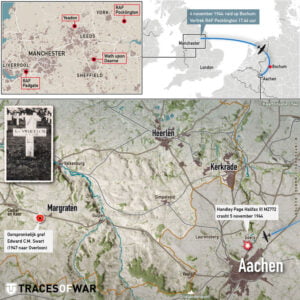
The MZ772 with Edward on board crashed near Laurensberg, 4 kilometres northwest of Aachen, Germany, according to official records. The exact time and cause of loss has never been established, according to the Aircraft Loss Card compiled by the Air Historical Branch after the war. It is therefore also not known whether the aircraft was en route to Bochum or back from Bochum. However, although Laurensberg was close by, the likely crash site was Soers. Two eyewitnesses are the main primary sources for this.
Seven graves, four cemeteries
The ‘loss record’ of this flight shows us that the seven crew members were all found, presumably by the Americans, in the recently liberated area. Documentation of this on the American side was probably non-existent due to the chaos. They were initially buried (as British) in an American cemetery first, reinforcing the assumption that all the crew members were recovered by the Americans at the crash site or near it.
It is notable, however, that all crew members except Edward were buried at Henri-Chapelle American Cemetery, while Edward was buried at Margaten American Cemetery, Netherlands. Then, in 1947, all seven were transferred back to their nearest Commonwealth war cemetery. This is how the six eventually ended up at Hotton War Cemetery in Belgium. Apparently, Edward and the other crew members were buried in Germany at different times or places, which may explain the two different burial locations.
Edward was eventually reburied in the Commonwealth War Cemetery Overloon on 1 May 1947. Thus ended the story of a Briton with Dutch roots in a quiet, green cemetery in the Netherlands, where he rests to this day.
Awards

credits
Lennard Bolijn team TracesofWar
Various photo’s Marja van Heusden
– Westfield Mills Wool Factory, Stephen Craven, Geograph.co.uk.
– The Yorkshire Evening Post, October 17, 1945.
– Timenote.info – Edward Cornelius Martin Swart
– Air Forces WW2 Casualty : Sergeant E C M SWART (1486325), Royal Air Force Volunteer Reserve [RAFCommands]
– Sergeant Edward Cornelius Martin Swart | War Casualty Details 1486325 | CWGC
– Edward Cornelius Martin Swart (1920 – 1944) – Genealogy
– SGLO Verliesregister
– Edward Cornelius Martin Swart’s Family Tree
– Pocklington History
– Forces War Records – Record Details for E C M Swart (Raf Pocklington)
– Forces War Records
– RAFcommands.com
– Westfield Mills
Sources
Timenote.info – Edward Cornelius Martin Swart
Air Forces WW2 Casualty : Sergeant E C M SWART (1486325), Royal Air Force Volunteer Reserve [RAFCommands]
Sergeant Edward Cornelius Martin Swart | War Casualty Details 1486325 | CWGC
Edward Cornelius Martin Swart (1920 – 1944) – Genealogy
SGLO Verliesregister
Edward Cornelius Martin Swart’s Family Tree
https://pocklingtonhistory.com/history/20thcentury/pocklingtoninww2/AircraftLosses/Pock%20Losses%20(1%20Mar%202021).pdf
https://www.forces-war-records.co.uk/records/13984832/edward-swart-royal-air-force-royal-air-force/
https://www.rafcommands.com/forum/showthread.php?13206-RAF-Manpower-and-Deferred-Service
https://www.forces-war-records.co.uk/records/99239/sergeant-e-c-m-swart-royal-air-force-raf-pocklington/
https://www.aireboroughhistoricalsociety.co.uk/yeadon/westfield-mills-1979.aspx
Chorley: https://books.google.nl/books?id=I6jctAEACAAJ&dq=inauthor:%22W.+R.+Chorley%22+1944&hl=nl&sa=X&redir_esc=y
Service number RAF Padgate https://www.ab-ix.co.uk/pdfs/rfc_raf.pdf
https://discovery.nationalarchives.gov.uk/browse/r/h/C2503448
https://discovery.nationalarchives.gov.uk/details/a/A13531670 -> West Yorkshire Archive Service, Leeds, over dienstverband bij Edward Denison and Co.
Tagesbuch Antonia Jünger, Heimatsverein Kohlscheid
Laurensberger Heimatfreunde http://www.schuetzen-laurensberg.homepage.t-online.de/pages/heimat.html
